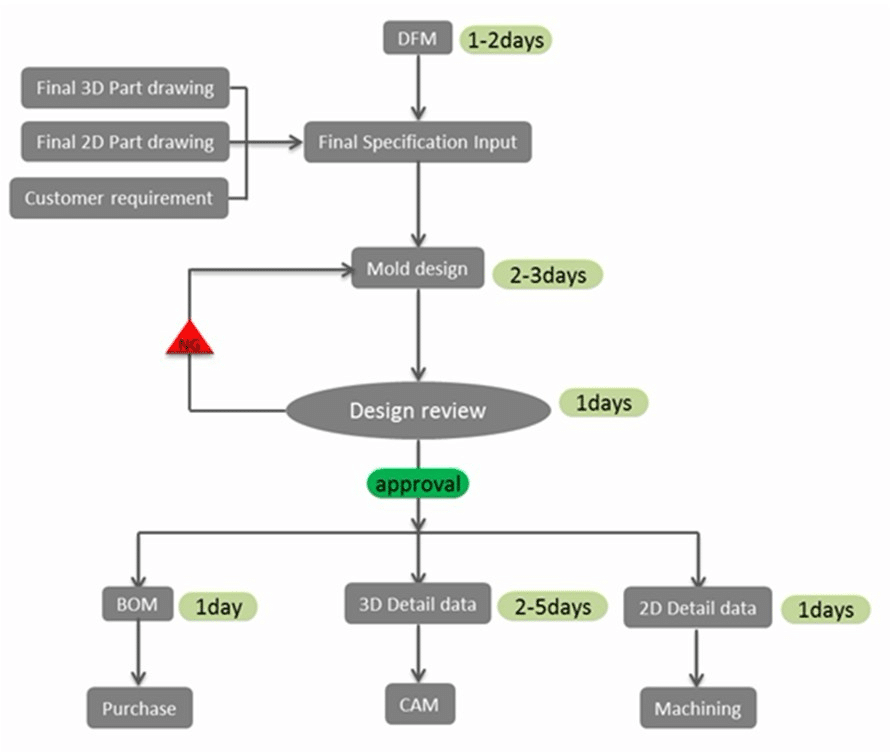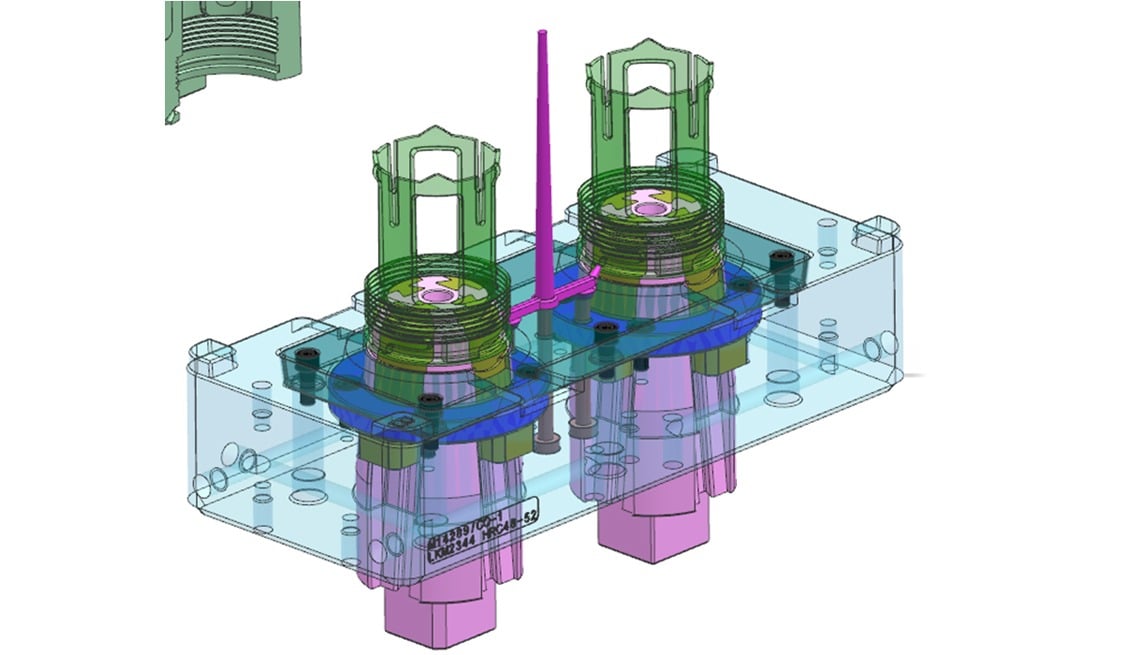Mold Design
A quality mold begins with quality design.
Our experienced designers are capable of creating simple to complex designs and assemblies in 2D and 3D formats.
*Suggested improvements on products design for better tooling if necessary
*Computer aided mold design
*Mold design according to different mold standards (DME, HASCO, etc.)
*Capabilities of doing 2D and 3D mold drawings
*Existing data exchange formats:
- 2D Part Drawings (.DWG, .DXF, .PDF)
- 3D Modeling (.STEP, .STL, .IGES, .X_T, .CATPart)
Mold Design:
There are many considerations for the design of injection mold. Here we will briefly introduce them to you.
1. In the design preparation stage, we should first determine what kind of injection molded parts to make. At the beginning of the design task, if the customer has a simple design drawing, it is necessary to adapt it according to the customer’s simple drawing to make a formal production drawing, and communicate with the customer repeatedly to determine the drawing. At the same time, the description and technical requirements, production output, sample size, surface roughness, volume and quality shall be indicated. Look through cases, collect relevant information, and sort out injection molding design data, molding process, molding equipment, machining and special processing data, which are ready for use.
2. Determine the molding method, determine the injection molding, and determine the production quantity.
3. Calculation of design process, such as calculation of working dimensions of concave and convex die parts; Determination of cavity wall thickness and base plate thickness; Determination of mold heating and cooling system.
4. At the same time, the service life of the injection mold, whether the customer puts forward the requirements, and how to meet the customer’s requirements, including the number of injections. Drawing of general assembly drawing of die structure and working drawing of parts, etc. For the cost problem, it depends on the region, enterprise, design difficulty, etc.
Win Win Mold has very good capabilities in mold design. We have got a set of the mature design processes, from parts analysis(DFM), mold flow analysis, structural analysis to process analysis. The software we use is Unigraphics, Pro-E and CAD.
All designers at Win Win Mold have more than 10 years of experience in exporting tooling design. They are able to read customer’s requirements in English and familiar with North American and European standards, like DME, HASCO, MEUSBURGER, etc. We are able to design more than 30 sets of complex molds monthly.
Mold design is mainly for machinery, mold, automobile, aviation, medicine and other industries. It can be engaged in mold design and manufacturing, product structure design and development, equipment debugging and management, NC operation and programming, production technology management and other related technical work.
What are the steps in mold design?
1. Analyze the feasibility of the products designed for the mold to ensure the correctness of the product drawings before the mold design. On the other hand, we can be familiar with the importance of the components in the entire chassis to determine the key dimensions.
2. Work to be done after product analysis, analyze what kind of mold structure the product adopts, and sort the products.
3. Material preparation: prepare materials according to the product development drawing. Determine the size of the template in the drawing, including each fixed plate, discharge plate, male and female die, insert, etc. Pay attention to preparing materials directly in the product development drawing, which is very beneficial to drawing the mold drawing.
4. After the material preparation is completed, you can fully enter the drawing of the mold drawing, and make a new copy in the material preparation drawing to draw each component. In addition, in the process of drawing the mold drawing, it should be noted that each production, such as bench marks, wire cutting, etc. Different machining processes have complete layers, which is of great benefit to wire cutting and drawing management.
5. Check the mold drawing, set the accessories, make different layers for each different template, analyze the mold setting with the same benchmark, such as the guide post hole, and insert the product development drawing of each process into the setting drawing to ensure that the hole positions of each template are consistent, and whether the upper and lower mold clearance at the bending position is correct.

mold design
Injection Mold Design Steps
The design of the injection mold must follow the following steps:
(1) Plastic analysis
1. Specify the design requirements of plastic parts
Carefully read the part drawing of plastic parts, and consider the feasibility and economy of injection molding process from various aspects such as the plastic variety, plastic shape, dimensional accuracy, surface roughness, etc. If necessary, discuss with the product designer about the possibility of material type and structure modification of plastic parts.
2. Specify the production batch of plastic parts
In small batch production, the mold shall be as simple as possible to reduce the cost; In mass production, under the premise of ensuring the quality of plastic parts, try to use the first mock examination with multiple cavities or high-speed automatic production to shorten the production cycle and improve productivity. Therefore, strict requirements are put forward for the ejection mechanism of the mold, the automatic ejection mechanism of plastic parts and runner aggregates.
3. Calculate the volume and mass of plastic parts
The purpose of calculating the volume and quality of plastic parts is to select injection molding machines, improve equipment utilization and determine the number of mold cavities.
(2) Selection of injection molding machine
Roughly determine the structure of the mold according to the volume or weight of the plastic parts, preliminarily determine the model of the injection molding machine, understand the technical parameters of the injection molding machine used related to the design of the mold, such as: the diameter of the positioning ring of the injection molding machine, the hole diameter and spherical radius of the front nozzle, the maximum injection volume of the injection molding machine, the mold locking force, the injection pressure, the area size of the fixed template and the movable template and the position of the installation screw hole, the spacing of the pull rod of the injection molding machine, the closing thickness, the mold opening stroke, Ejection stroke, etc.
(3) Calculation related to die design
1. Calculation of working dimensions of concave and convex die parts;
2. Determination of cavity wall thickness and base plate thickness;
3. Determination of mold heating and cooling system.
(4) Mold structure design
1. Selection of molding position and parting surface of plastic parts;
2. Determination of mold cavity number, cavity arrangement, runner layout and gate position setting;
3. Structural design of die working parts;
4. Design of side parting and core pulling mechanism;
5. Ejection mechanism design;
6. Type selection of draw bar;
7. Exhaust mode design.
(5) Determine the overall dimension of the mold, and purchase the mold base
The mold base has been standardized gradually. The mold base is selected according to the mold base atlas provided by the manufacturer, and the complete structure diagram of the mold is preliminarily drawn on the basis of the above mold parts design.
(6) Verification of injection molding machine parameters
1. Check the maximum injection quantity;
2. Check the injection pressure;
3. Check the clamping force;
4. Check the relevant dimensions of the installation part of the mold and injection molding machine, including the closing height, mold opening stroke, mold base installation dimensions, etc.
(7) Drawing of die structure general assembly drawing and part working drawing
The drawing of the general drawing of the mold must conform to the national standard of mechanical drawing. In principle, there is no difference between the drawing method and the general drawing method of mechanical drawing, but in order to more clearly express the shape of the molded products in the mold and the setting of the gate position, the fixed mold can be removed from the top view of the general drawing of the mold, and only the top view of the moving mold can be drawn.
The general assembly drawing of the mold should include necessary dimensions, such as mold closing dimension, overall dimension, feature dimension (the dimension of the locating ring matched with the injection molding machine), assembly dimension, limit dimension (the starting and ending points of moving parts) and technical conditions, and the preparation of parts list.
Generally, the processing cycle of the main working parts is long and the processing accuracy is high, so they should be carefully drawn first, and the remaining parts should be standard parts as far as possible.
(8) Overall review of production and manufacturing
Mold designers shall generally participate in the whole process of processing, assembly, mold testing and production.









